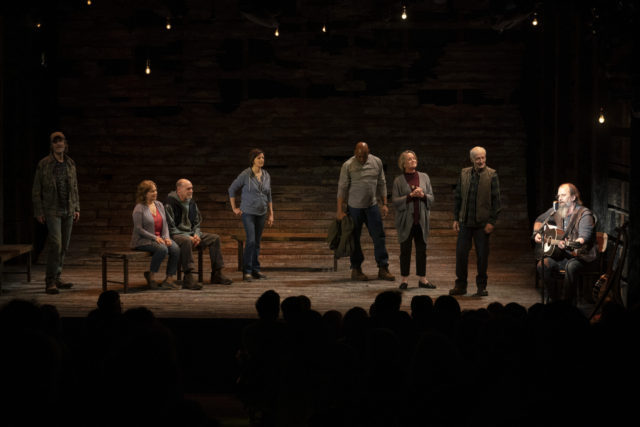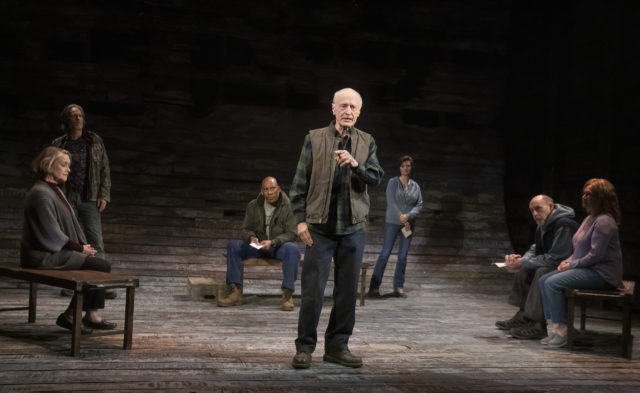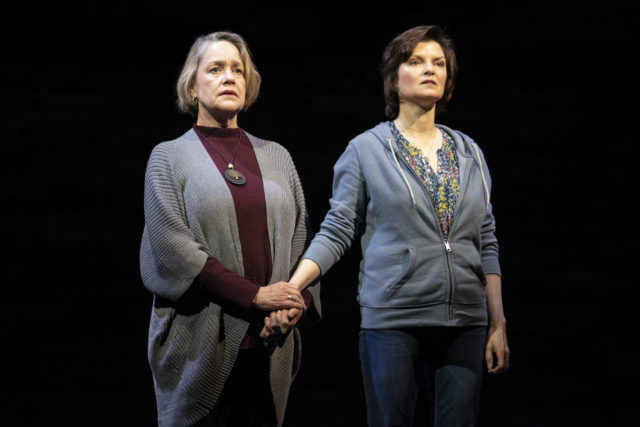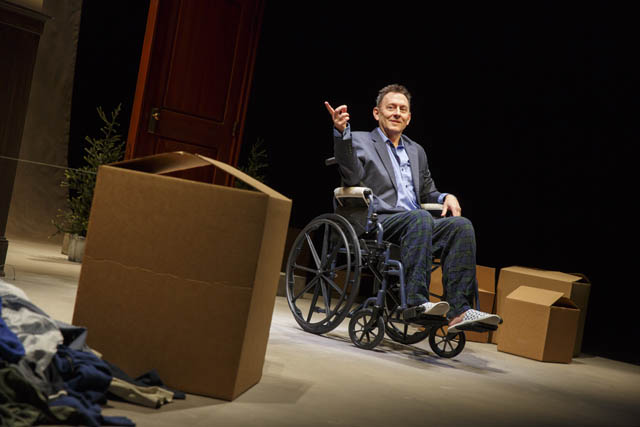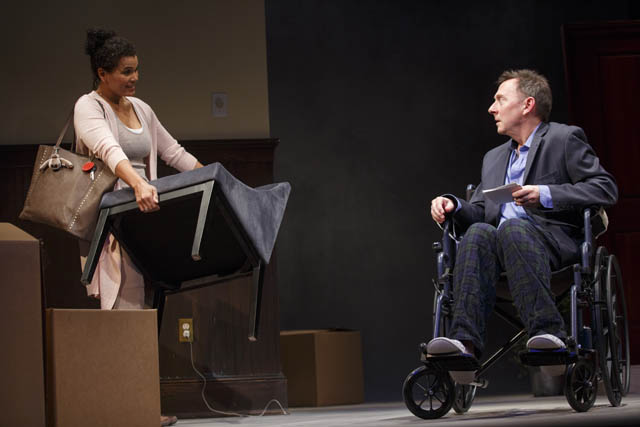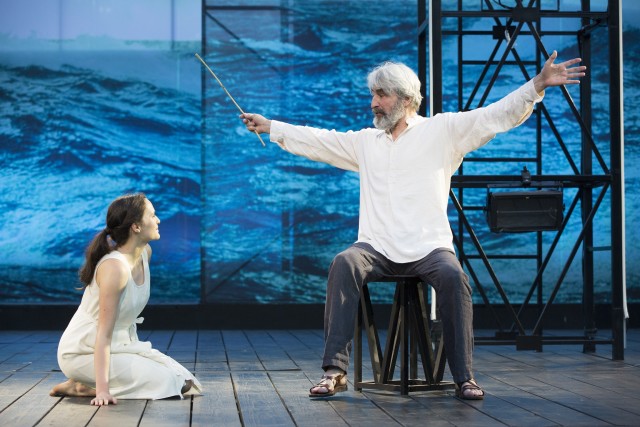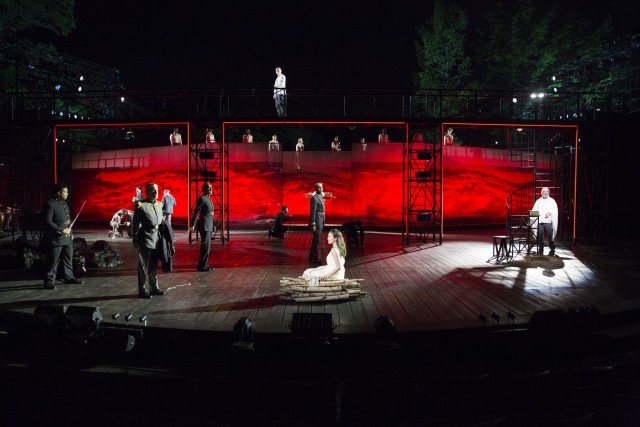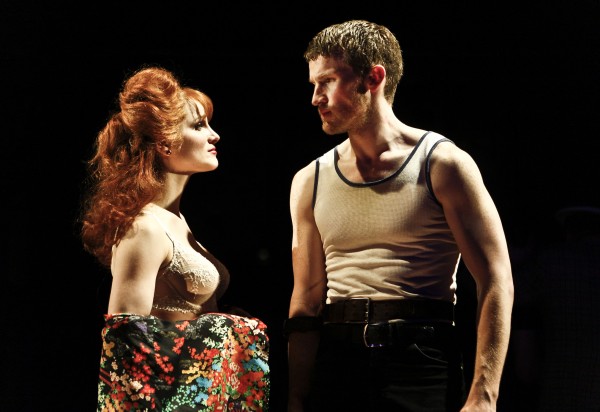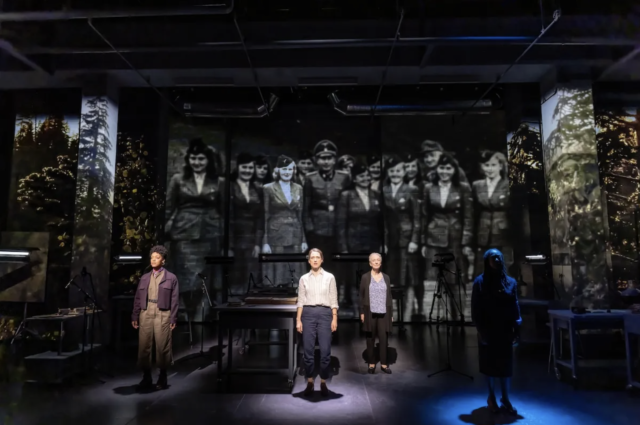
Here There Are Blueberries explores a remarkable album of photos taken at Auschwitz (photo © Matthew Murphy)
HERE THERE ARE BLUEBERRIES
New York Theatre Workshop
79 East Fourth St. between Second & Third Aves.
Tuesday – Sunday through June 30, $105-$125
www.nytw.org
When you enter New York Theatre Workshop to see Here There Are Blueberries, there’s a projection of the Leica logo on a translucent curtain behind an actual camera on a stand on the stage. “In the 1930s, the development of compact, portable cameras like this one changed everything,” an actor says in a prologue, explaining that as Germany emerged from a national depression, citizens started taking photos as an affordable hobby in the pursuit of happiness. “Each pose, each press of a button, each frozen moment tells the world: This is our shared history, and this is what it means to us. Viewed in this way, the apparent ordinariness of these images does not detract from their political relevance. On the contrary: Asserting ordinariness in the face of the extraordinary is, in itself, an immensely political act.”
According to the September 2020 U.S. Millennial Holocaust Knowledge and Awareness Survey, the first national poll ever taken of millennials and Gen Z about the Holocaust, sixty-three percent of respondents did not know that six million Jews were killed by the Nazis, forty-eight percent could not name a single concentration camp or European ghetto, and twenty percent believed that the Jews caused the Holocaust. As more survivors and witnesses pass away and antisemitism grows around the world, those numbers are only likely to increase, which is why a play such as the exquisitely rendered Here There Are Blueberries is so timely and necessary.
Running at New York Theatre Workshop through June 30, the gripping hundred-minute drama from the Tectonic Theater Project pores over the contents of a book of photos delivered to the U.S. Holocaust Memorial Museum in 2007 by an eighty-seven-year-old retired U.S. lieutenant colonel (Grant James Varjas); he had been holding on to them since he discovered them in an abandoned Frankfurt apartment in 1946. There was something unique and unexpected — and terrifying — about the pictures: They did not contain a single image of a victim or prisoner.
With limited information, the archival team, led by Dr. Rebecca Erbelding (Elizabeth Stahlmann) and Judy Cohen (Kathleen Chalfant), begin a detailed forensic investigation that yields a surprising result: The photos are of Nazi officers and Helferinnen, a communication corps of young women, enjoying themselves at Auschwitz, exploring the facilities, laughing and singing, and relaxing at the previously unknown chalet known as Solahütte, where weekends were awarded to hard workers, a bonus for a job well done — asserting ordinariness in the face of the extraordinary, examples of what Jewish historian and philosopher Hannah Arendt, who fled Germany with her family in 1933, referred to as “the banality of evil.”
As the museum archive team starts identifying the men in the photos — among those seen in large projections on the back wall are Dr. Josef Mengele, Commandant SS Major Richard Baer, chief SS doctor Eduard Wirths, Auschwitz builder Rudolph Höss, and his right-hand man, former bank clerk SS Obersturmführer Karl Höcker (Scott Barrow), who owned the album — it reaches out to descendants of the subjects, some of whom are shocked to find out what their fathers and grandfathers were up to. One, Tilman Taube (Jonathan Raviv), decides to help the museum track down more relatives in order to gather further information. “Those who say nothing . . . they transfer this trauma to the next generation,” he bravely argues.
Meanwhile, Dr. Erbelding, Cohen, and museum director Sara Bloomfield (Erika Rose) debate whether the photographs should be put on display. “Here we find our first obstacle. There’s a sense at our museum that we should focus on the victims, not on the perpetrators,” Cohen says. Bloomfield replies, “In the creation of the permanent exhibition of the United States Holocaust Memorial Museum, special effort has been made to avoid undue attention to the perpetrators and to humanize and honor the victims.” Shortly after a survivor declares that the museum should let the public see the pictures for themselves, Bloomfield says, “We don’t want to elevate Nazis, to give them any kind of platform.”
The photographs that give the play its name are a series of shots of Höcker with a group of Helferinnen in skirts sitting on a fence on the Solahütte deck, eating blueberries, all smiles as they pose for the camera; one of the young women pretends to cry because her bowl is empty. “People called us and said — these people look normal, the girls look like teenage girls. Because they were. And that was surprising, that they look like us!” Dr. Erbelding explains. The caller continued, “‘I know I never could’ve been a Mengele. I know I never could’ve been a Höcker. But could I have been a Helferin?’”
And therein lies the dilemma at the heart of the play: What would any of us have done in that situation — and what would we do today?
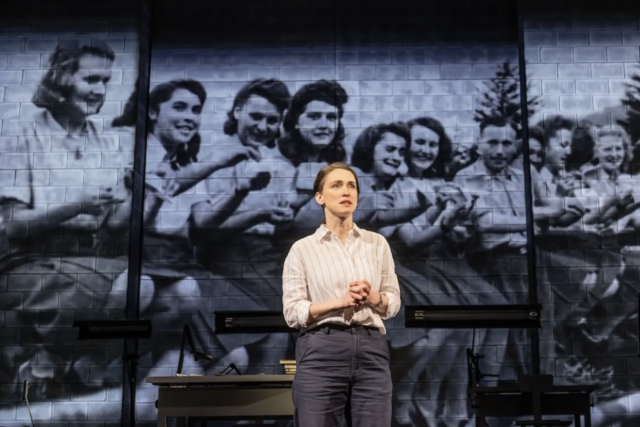
Dr. Rebecca Erbelding (Elizabeth Stahlmann) leads a team at the U.S. Holocaust Memorial Museum in gripping play (photo © Matthew Murphy)
Using their Moment Work method of collaboration, Tectonic Theater Project and founding artistic director Moisés Kaufman have created such fact-based narrative plays as The Laramie Project, 33 Variations, I Am My Own Wife, and Gross Indecency: The Three Trials of Oscar Wilde. Conceived and directed by Tony and Emmy nominee Kaufman — inspired by the 2007 New York Times article “In the Shadow of Horror, SS Guardians Frolic” — and cowritten by Kaufman and Emmy nominee Amanda Gronich, Here There Are Blueberries takes the audience inside the tense research and analysis as the museum realizes how important the evidence is.
The album served as visual reference for the Oscar-nominated film The Zone of Interest, a fictionalized version of the everyday life of Höss and his family, who lived next door to Auschwitz. It also has much in common with Bianca Stigter’s astounding 2021 documentary, Three Minutes — A Lengthening, which follows the U.S. Holocaust Memorial Museum as it tries to uncover the details about a mysterious 180-second home-movie clip from Poland in 1938, searching for the exact location, who is in the footage, and what happened to the citizens of this community.
Derek McLane’s set is a research room containing several standing desks where characters in Dede Ayite’s everyday costumes conduct their analyses; David Lander’s clear-cut lighting includes overhead industrial fluorescents and illuminates individual speakers, while Bobby McElver’s sound ranges from the accordion and a storm to chirping birds, a flowing river, and marching feet. David Bengali’s bold projections of the photos, news reports, related documents, and maps makes the audience feel like they are part of the research team, especially with close-ups and when a particular figure in a photo is lit up or silhouetted. A few instances of live video are distracting and unnecessary, but they are kept to a minimum.
Stahlmann (Slave Play, Pushkin “Eugene Onegin” in our own words) and Tony nominee Chalfant (Angels in America, Novenas for a Lost Hospital) lead a strong ensemble cast (which also includes Noah Keyishian, Anna Shafer, and Charlie Thurston) that smoothly handles multiple roles. The material is treated with a gentle sensitivity that makes the various revelations all the more powerful.
Early on, Dr. Erbelding concludes, “This album is something [Höcker] treasured. There are no ink blots, he doesn’t misspell anything, he made sure the lettering was right. Everything is glued perfectly. This was meant to last.” After the show, as the audience exits, facsimiles of many of the photos are on display in the lobby, a potent reminder that the story that has just been told is true and that the snapshots are real.
I know that for me, one thing that is going to last from this play: I will never be able to look at blueberries the same way again.
[The June 4 and 12 performances will be followed by discussions with the Fellowships at Auschwitz for the Study of Professional Ethics. Mark Rifkin is a Brooklyn-born, Manhattan-based writer and editor; you can follow him on Substack here.]
